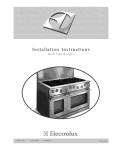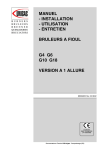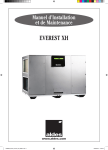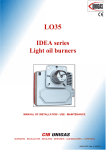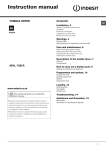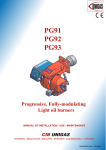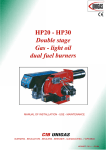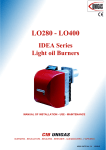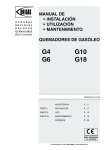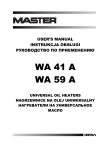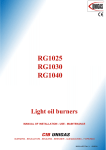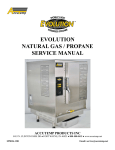Download G6 - G10 - G18 - Arzatoare CIB Unigas
Transcript
G6 - G10 - G18 24 Vdc voltage supplied single stage burners MANUAL OF INSTALLATION - USE - MAINTENANCE BURNERS - BRUCIATORI - BRULERS - BRENNER - QUEMADORES - ГОРЕЛКИ M039223CB Rev. 1.2 06/2010 TABLE OF CONTENTS WARNINGS ............................................................................................................................................................... 3 PART I: INSTALLATION ........................................................................................................................................... 5 GENERAL FEATURES ................................................................................................................................................................... 5 How to interpret the burner “Performance curve” ........................................................................................................................... 5 Matching the burner to the boiler .................................................................................................................................................... 6 Burner model identification ............................................................................................................................................................. 7 Specifications ................................................................................................................................................................................. 7 Overall dimensions ......................................................................................................................................................................... 8 Performance Curves ....................................................................................................................................................................... 8 MOUNTINGS AND CONNECTIONS .............................................................................................................................................. 9 Packing ........................................................................................................................................................................................... 9 Fitting the burner to the boiler ......................................................................................................................................................... 9 Hydraulic diagrams for light oil supplying circuits ......................................................................................................................... 10 Installation diagram of light oil pipes ............................................................................................................................................. 11 About the use of fuel pumps ......................................................................................................................................................... 11 Light oil pumps .............................................................................................................................................................................. 12 Connecting the light oil flexible hoses ........................................................................................................................................... 12 Electrical connections ................................................................................................................................................................... 12 ADJUSTMENTS ........................................................................................................................................................................... 14 Adjustments - brief description ...................................................................................................................................................... 14 Adjustment procedure ................................................................................................................................................................... 14 Adjusting the combsution head ..................................................................................................................................................... 16 PART II: OPERATION ............................................................................................................................................. 17 OPERATION ................................................................................................................................................................................. 17 PART III: MAINTENANCE....................................................................................................................................... 18 ROUTINE MAINTENANCE........................................................................................................................................................... 18 Light oil filter maintenance ............................................................................................................................................................ 18 Removing the combustion head ................................................................................................................................................... 18 Cleaning and replacing the detection photocell ............................................................................................................................ 19 Checking the detection current ..................................................................................................................................................... 20 Seasonal stop ............................................................................................................................................................................... 20 Burner disposal ............................................................................................................................................................................. 20 TROUBLESHOOTING .................................................................................................................................................................. 21 BURNER EXPLODED VIEW ........................................................................................................................................................ 22 SPARE PARTS ............................................................................................................................................................................. 24 APPENDIX 2 WARNINGS THIS MANUAL IS SUPPLIED AS AN INTEGRAL AND ESSENTIAL PART OF THE PRODUCT AND MUST BE DELIVERED TO THE USER. INFORMATION INCLUDED IN THIS SECTION ARE DEDICATED BOTH TO THE USER AND TO PERSONNEL FOLLOWING PRODUCT INSTALLATION AND MAINTENANCE. THE USER WILL FIND FURTHER INFORMATION ABOUT OPERATING AND USE RESTRICTIONS, IN THE SECOND SECTION OF THIS MANUAL. WE HIGHLY RECOMMEND TO READ IT. CAREFULLY KEEP THIS MANUAL FOR FUTURE REFERENCE. 1) GENERAL INTRODUCTION shall have qualified personnel carry out the following operations: a Remove the power supply by disconnecting the power cord from the mains. b) Disconnect the fuel supply by means of the hand-operated shut-off valve and remove the control handwheels from their spindles. z The equipment must be installed in compliance with the regulations in force, following the manufacturer’s instructions, by qualified personnel. z Qualified personnel means those having technical knowledge in the field of components for civil or industrial heating systems, sanitary hot water generation and particularly service centres authorised by the manufacturer. z Improper installation may cause injury to people and animals, or damage to property, for which the manufacturer cannot be held liable. z Remove all packaging material and inspect the equipment for integrity. In case of any doubt, do not use the unit - contact the supplier. The packaging materials (wooden crate, nails, fastening devices, plastic bags, foamed polystyrene, etc), should not be left within the reach of children, as they may prove harmful. z Before any cleaning or servicing operation, disconnect the unit from the mains by turning the master switch OFF, and/or through the cutout devices that are provided. z Make sure that inlet or exhaust grilles are unobstructed. z In case of breakdown and/or defective unit operation, disconnect the unit. Make no attempt to repair the unit or take any direct action. Contact qualified personnel only. Units shall be repaired exclusively by a servicing centre, duly authorised by the manufacturer, with original spare parts. Failure to comply with the above instructions is likely to impair the unit’s safety. To ensure equipment efficiency and proper operation, it is essential that maintenance operations are performed by qualified personnel at regular intervals, following the manufacturer’s instructions. z When a decision is made to discontinue the use of the equipment, those parts likely to constitute sources of danger shall be made harmless. z In case the equipment is to be sold or transferred to another user, or in case the original user should move and leave the unit behind, make sure that these instructions accompany the equipment at all times so that they can be consulted by the new owner and/or the installer. z For all the units that have been modified or have options fitted then original accessory equipment only shall be used. z This unit shall be employed exclusively for the use for which it is meant. Any other use shall be considered as improper and, therefore, dangerous. The manufacturer shall not be held liable, by agreement or otherwise, for damages resulting from improper installation, use and failure to comply with the instructions supplied by the manufacturer. Special warnings z Make sure that the burner has, on installation, been firmly secured to the appliance, so that the flame is generated inside the appliance firebox. z Before the burner is started and, thereafter, at least once a year, have qualified personnel perform the following operations: a set the burner fuel flow rate depending on the heat input of the appliance; b set the flow rate of the combustion-supporting air to obtain a combustion efficiency level at least equal to the lower level required by the regulations in force; c check the unit operation for proper combustion, to avoid any harmful or polluting unburnt gases in excess of the limits permitted by the regulations in force; d make sure that control and safety devices are operating properly; e make sure that exhaust ducts intended to discharge the products of combustion are operating properly; f on completion of setting and adjustment operations, make sure that all mechanical locking devices of controls have been duly tightened; g make sure that a copy of the burner use and maintenance instructions is available in the boiler room. z In case of a burner shut-down, reser the control box by means of the RESET pushbutton. If a second shut-down takes place, call the Technical Service, without trying to RESET further. z The unit shall be operated and serviced by qualified personnel only, in compliance with the regulations in force. 3) z z z z z 2) GENERAL INSTRUCTIONS DEPENDING ON FUEL USED 3a) SPECIAL INSTRUCTIONS FOR BURNERS z z The burner should be installed in a suitable room, with ventilation openings complying with the requirements of the regulations in force, and sufficient for good combustion. z Only burners designed according to the regulations in force should be used. z This burner should be employed exclusively for the use for which it was designed. z Before connecting the burner, make sure that the unit rating is the same as delivery mains (electricity, gas oil, or other fuel). z Observe caution with hot burner components. These are, usually, near to the flame and the fuel pre-heating system, they become hot during the unit operation and will remain hot for some time after the burner has stopped. When the decision is made to discontinue the use of the burner, the user ELECTRICAL CONNECTION For safety reasons the unit must be efficiently earthed and installed as required by current safety regulations. It is vital that all saftey requirements are met. In case of any doubt, ask for an accurate inspection of electrics by qualified personnel, since the manufacturer cannot be held liable for damages that may be caused by failure to correctly earth the equipment. Qualified personnel must inspect the system to make sure that it is adequate to take the maximum power used by the equipment shown on the equipment rating plate. In particular, make sure that the system cable cross section is adequate for the power absorbed by the unit. No adaptors, multiple outlet sockets and/or extension cables are permitted to connect the unit to the electric mains. An omnipolar switch shall be provided for connection to mains, as required by the current safety regulations. The use of any power-operated component implies observance of a few basic rules, for example: - do not touch the unit with wet or damp parts of the body and/or with bare feet; - do not pull electric cables; - do not leave the equipment exposed to weather (rain, sun, etc.) unless expressly required to do so; - do not allow children or inexperienced persons to use equipment; z The unit input cable shall not be replaced by the user. In case of damage to the cable, switch off the unit and contact qualified personnel to replace. When the unit is out of use for some time the electric switch supplying all the power-driven components in the system (i.e. pumps, burner, etc.) should be switched off. 3 DIRECTIVES AND STANDARDS Gas burners European directives: - Directive 90/396/CEE - Gas Appliances; - Directive 2006/95/EC on low voltage; - Directive 2004/108/CEE on electromagnetic compatibility Harmonised standards : -UNI EN 676 (Gas Burners; -CEI EN 60335-1(Household and similar electrical appliances - Safety. Part 1: General requirements; - EN 50165 (Electrical equipment of non-electric appliances for household and similar purposes. Safety requirements. 3b) FIRING WITH GAS, LIGHT OIL OR OTHER FUELS GENERAL z The burner shall be installed by qualified personnel and in compliance with regulations and provisions in force; wrong installation can cause injuries to people and animals, or damage to property, for which the manufacturer cannot be held liable. z Before installation, it is recommended that all the fuel supply system pipes be carefully cleaned inside, to remove foreign matter that might impair the burner operation. z Before the burner is commissioned, qualified personnel should inspect the following: a the fuel supply system, for proper sealing; b the fuel flow rate, to make sure that it has been set based on the firing rate required of the burner; c the burner firing system, to make sure that it is supplied for the designed fuel type; d the fuel supply pressure, to make sure that it is included in the range shown on the rating plate; e the fuel supply system, to make sure that the system dimensions are adequate to the burner firing rate, and that the system is equipped with all the safety and control devices required by the regulations in force. z When the burner is to remain idle for some time, the fuel supply tap or taps should be closed. Light oil burners European directives: - Directive 2006/95/EC on low voltage; - Directive 2004/108/CEE on electromagnetic compatibility Harmonised standards : -CEI EN 60335-1(Household and similar electrical appliances - Safety. Part 1: General requirements; - EN 50165 (Electrical equipment of non-electric appliances for household and similar purposes. Safety requirements. National standards : -UNI 7824: Monobloc nebulizer burners for liquid fuels. Characteristics and test methods SPECIAL INSTRUCTIONS FOR USING GAS Have qualified personnel inspect the installation to ensure that: a the gas delivery line and train are in compliance with the regulations and provisions in force; b all gas connections are tight; c the boiler room ventilation openings are such that they ensure the air supply flow required by the current regulations, and in any case are sufficient for proper combustion. z Do not use gas pipes to earth electrical equipment. z Never leave the burner connected when not in use. Always shut the gas valve off. z In case of prolonged absence of the user, the main gas delivery valve to the burner should be shut off. Precautions if you can smell gas a do not operate electric switches, the telephone, or any other item likely to generate sparks; b immediately open doors and windows to create an air flow to purge the room; c close the gas valves; d contact qualified personnel. z Do not obstruct the ventilation openings of the room where gas appliances are installed, to avoid dangerous conditions such as the development of toxic or explosive mixtures. Heavy oil burners European directives: - Directive 2006/95/EC on low voltage; - Directive 2004/108/CEE on electromagnetic compatibility Harmonised standards : -CEI EN 60335-1 Household and similar electrical appliances - SafetyPart 1: General requirements; - EN 50165 Electrical equipment of non-electric appliances for household and similar purposes. Safety requirements. National standards : -UNI 7824: Monobloc nebulizer burners for liquid fuels. Characteristics and test methods Gas - Light oil burners European directives: - Directive 90/396/CEE Gas Appliances; - Directive 2006/95/EC on low voltage; - Directive 2004/108/CEE on electromagnetic compatibility Harmonised standards : -UNI EN 676 Gas Burners -CEI EN 60335-1(Household and similar electrical appliances - Safety. Part 1: General requirements; - EN 50165 Electrical equipment of non-electric appliances for household and similar purposes. Safety requirements. National standards : -UNI 7824: Monobloc nebulizer burners for liquid fuels. Characteristics and test methods Gas - Heavy oil burners European directives: - Directive 90/396/CEE - Gas Appliances; - Directive 2006/95/EC on low voltage; - Directive 2004/108/CEE on electromagnetic compatibility Harmonised standards : -UNI EN 676 (Gas Burners; -CEI EN 60335-1(Household and similar electrical appliances - Safety. Part 1: General requirements; - EN 50165 Electrical equipment of non-electric appliances for household and similar purposes. Safety requirements. National standards : -UNI 7824: Monobloc nebulizer burners for liquid fuels. Characteristics and test methods 4 C.I.B. UNIGAS - M039223CB PART I: INSTALLATION GENERAL FEATURES This series represents monobloc gas burners made in die-cast aluminium housing, the combustion head position can be adjustedwhich allows a good performance. 1 5 4 2 3 1 2 3 4 Gas valve group Blast tube-Combustion head ass.y Burner flange Burner cover The fuel coming from the supply line, is pushed by the pump to the nozzle and then into the combustion chamber, where the mixture between fuel and air takes place and consequently the flame. In the burners, the mixture bertween fuel and air, to perform clean and efficient combustion, is activated by atomisation of oil into very small particles. This process is achieved making pressurised oil passing through the nozzle. The pump main function is to transfer oil from the tank to the nozzle in the desired quantity and pressure. To adjust this pressure, pumps are provided with a pressure regulator (except for some models for which a separate regulating valve is provided). Other pumps are provided with two pressure regulators: one for the high and one for low pressure (in double-stage systems with one nozzle). The adjustable combustion head can improve the burner performance. The combustion head determines the energetic quality and the geometry of the flame. Fuel and comburent are routed into separated ways as far as the zone of flame generation (combustion chamber). How to interpret the burner “Performance curve” To check if the burner is suitable for the boiler to which it must be installled, the following parameters are needed: z furnace input, in kW or kcal/h (kW = kcal/h / 860); z backpressure (data are available on the boiler’s ID plate or in the user’s manual). Example: Furnace input: 600kW Backpressure: 4mbar In the “Performance curve” diagram (Fig. 2), draw a vertical line matching the furnace input value and an horizontal line matching the backpressure value. The burner is suitable if the intersection point A is inside the performance curve. 5 C.I.B. UNIGAS - M039223CB Campo di lavoro bruciatori Tipo P60 Mod. M-xx.x.IT.A.0.50 - M-.xx.x.IT.A.0.65 Contropressione in camera di combustione mbar 8 7 6 5 A 4 3 2 1 0 -1 100 200 300 400 500 600 700 800 900 Potenza kW Fig. 1 Data are referred to standard conditions: atmospheric pressure at 1013mbar, ambient temperature at 15°C Matching the burner to the boiler The burners described in this manual have been tested with combustion chambers that comply with EN676 regulation and whose dimensions are described in the diagram . In case the burner must be coupled with boilers with a combustion chamber smaller in diameter or shorter than those described in the diagram, please contact the supplier, to verify that a correct matching is possible, with respect of the application involved. To correctly match the burner to the boiler verify the necessary input and the pressure in combustion chamber are included in the burner performance curve; otherwise the choice of the burner must be revised consulting the burner manufacturer. To choose the blast tube lenght follow the instructions of the boiler manufacturer. In absence of these consider the following: z Cast-iron boilers, three pass flue boilers (with the first pass in the rear part): the blast tube must protrude no more than 100 mm into the combustion chamber. z Pressurised boilers with flame reversal: in this case the blast tube must penetrate at least 50 - 100 mm into combustion chamber in respect to the tube bundle plate. The length of the blast tubes does not always allow this requirement to be met, and thus it may be necessary to use a suitably-sized spacer to move the burner backwards or to design a blast tube tha suites the utilisation (please, contact the manifacturer). Key a) Heat output in kW b) Lenght of the flame tube in meters c) Flame tube firing intensity in MW/m3 d) Combustion chamber diameter (m) Fig. 2 - Firing intensity, diameter and lenght of the test flame tube as a function of the heat input in kW. Fig. 2 6 C.I.B. UNIGAS - M039223CB Burner model identification Burners are identified by burner type and model. Burner model identification is described as follows. Type G10 Model G-. (1) (2) (1) BURNER TYPE (2) FUEL (3) OPERATION (Available versions) (4) BLAST TUBEBLAST TUBE (5) DESTINATION COUNTRY (6) BURNER VERSION TN. (3) S. (4) *. (5) Y. (6) G6 - G10 - G18 G - Light oil TN - Single stage S - Standard L - Extended * - see data plate Y - Special version (24Vdc power supply) Specifications G6 BURNER TYPE Output min. -max. kW 29 - 70 Light oil viscosity Light oil density min. - max. kg/h 2.5 - 6 58 - 116 105 - 209 5 - 10 cSt @ 40°C 2 - 7.4 kg/m3 0.84 9 - 18 24 Vdc Power supply 110 180 180 W 210 280 280 kg 15.5 17 18 Motor W Total power consumption Weight (approx.) G18 Light oilLight oil Fuel Light oil rate G10 Single-stage Operation Operating temperature °C -10 ÷ +50 Storage Temperature °C -20 ÷ +60 NOTE: Choosing the nozzle for light oil, consider Hi equal to 10200 kcal/kg. * NOTE ON THE WORKING SERVICE: Burners provided with Siemens LOA24 control box: for safety reasons, one controlled shutdown must take place every 24 hours of continuous working. 7 C.I.B. UNIGAS - M039223CB Overall dimensions (mm) A B B(L*) C C(L*) D E F G H K M P G6 290 53 ÷ 67 53 ÷ 177 343 ÷ 357 343 ÷ 467 310 75 385 80 101 190 M8 112 G10 275 86 206 361 481 340 40 380 89 99 230 M8 132 G18 275 87 207 362 482 340 40 380 114 134 230 M8 132 *L = measure referred to burner provided with extended blast tube BACK PRESSURE IN COMBUSTION CHAMBER mbar Performance Curves 1,4 1,2 1 0,8 0,6 0,4 G6 G10 G18 0,2 0 10 30 50 70 90 110 130 150 170 190 210 230 kW To get the input in kcal/h, multiply value in kW by 860. Data are referred to standard conditions: atmospheric pressure at 1013mbar, ambient temperature at 15°C NOTE: The performance curve is a diagram that represents the burner performance in the type approval phase or in the laboratory tests, but does not represent the regulation range of the machine. On this diagram the maximum output point is usually reached by adjsuting the combustion head to its “MAX” position (see paragraph “Adjusting the combustion head”); the minimum output point is reached setting the combustion head to its “MIN” position. During the first ignition, the combustion head is set in order to find a compromise between the burner output and the generator specifications, that is why the minimum output may be different from the Performance curve minimum. 8 C.I.B. UNIGAS - M039223CB MOUNTINGS AND CONNECTIONS Packing Burners are despatched in cardboard packages whose dimensions are (mm): 340mm x 415mm x 415mm Packing cases of this kind are affected by humidity and are not suitable for stacking. The following are placed in each packing case: z burner with gas train detached; z gasket to be inserted between the burner and the boiler; z oil flexible hoses; z oil filter; z envelope containing this manual To get rid of the burner’s packing, follow the procedures laid down by current laws on disposal of materials Fitting the burner to the boiler 9 C.I.B. UNIGAS - M039223CB Hydraulic diagrams for light oil supplying circuits Fig. 3 - Gravity circuit Fig. 4 - Ring circuit Fig. 5 - Suction circuit Key 1 Manual valve 2 Light oil filter 3 Light oil feeding pump 4 One way valve 5 Flexible hoses 6 Relief valve NOTE: in plants where gravity or ring feed systems are provided, install an automatic interception device (see n. 4 - Fig. 6). 10 C.I.B. UNIGAS - M039223CB Installation diagram of light oil pipes PLEASE READ CAREFULLY THE “WARNINGS” CHAPTER AT THE BEGINNING OF THIS MANUAL. From tank To tank Fig. 6 - Double-pipe system The burner is supplied with filter and flexible hoses, all the parts upstream the filter and downstream the return flexible hose, must be installed by the customer. As far as the hoses connection, see the related paragraph. (*) Only for installations with gravity, siphon or forced circulation feed systems. If the device installed Key is a solenoid valve, a timer must be installed to 1 Burner delay the valve closing. 2 Flexible hoses (fitted) The direct connection of the device without a timer 3 Light oil filter (fitted) may cause pump breaks. 4 Automatic interceptor (*) 5 One-way valve (*) 6 Gate valve 7 Quick-closing gate-valve (outside the tank or boiler rooms) The pumps that are used can be installed both into single-pipe and double-pipe systems. Single-pipe system: a single pipe drives the oil from the tank to the pump’s inlet. Then, from the pump, the pressurised oil is driven to the nozzle: a part comes out from the nozzle while the othe part goes back to the pump. In this system, the by-pass pulg, if provided, must be removed and the optional return port, on the pump’s body, must be sealed by steel plug and washer. Double-pipe system: as for the single pipe system, a pipe that connects the tank to the pump’s inlet is used besides another pipe that connects the pum’s return port to the tank, as well. The excess of oil goes back to the tank: this installation can be considered self-bleeding. If provided, the inside by-pass plug must be installed to avoid air and fuel passing through the pump. Burners come out from the factory provided for double-stage systems. They can be suited for single-pipe system (recommended in the case of gravity feed) as decribed before. To change from a 1-pipe system to a 2-pipe-system, insert the by-pass plug G (as for ccwrotation- referring to the pump shaft). Caution: Changing the direction of rotation, all connections on top and side are reversed. Bleed Bleeding in two-pipe operation is automatic : it is assured by a bleed flat on the piston. In one-pipe operation, the plug of a pressure gauge port must be loosened until the air is evacuated from the system. About the use of fuel pumps z z z z z z z z Make sure that the by-pass plug is not used in a single pipe installation, because the fuel unit will not function properly and damage to the pump and burner motor could result. Do not use fuel with additives to avoid the possible formation over time of compounds which may deposit between the gear teeth, thus obstructing them. After filling the tank, wait before starting the burner. This will give any suspended impurities time to deposit on the bottom of the tank, thus avoiding the possibility that they might be sucked into the pump. On initial commissioning a "dry" operation is foreseen for a considerable length of time (for example, when there is a long suction line to bleed). To avoid damages inject some lubrication oil into the vacuum inlet. Care must be taken when installing the pump not to force the pump shaft along its axis or laterally to avoid excessive wear on the joint, noise and overloading the gears. Pipes should not contain air pockets. Rapid attachment joint should therefore be avoided and threaded or mechanical seal junctions preferred. Junction threads, elbow joints and couplings should be sealed with removable sg component. The number of junctions should be kept to a minimum as they are a possible source of leakage. Do not use PTFE tape on the suction and return line pipes to avoid the possibility that particles enter circulation. These could deposit on the pump filter or the nozzle, reducing efficiency. Always use O-Rings or mechanical seal (copper or aluminium gaskets) junctions if possible. An external filter should always be installed in the suction line upstream of the fuel unit. 11 C.I.B. UNIGAS - M039223CB Light oil pumps Pump DELTA A Oil viscosity Oil temperature Maximum inlet pressure Maximum Return pressure 1.2 ÷ 12 mm²/s (cSt) 60 °C max 2 bar 2 bar Minimum inlet pressure Maximum speed - 0.5 bar to avoid gasing 3500 rpm Keys 1 pressure governor 4 By-pass 5 Return 6 Inlet 7 Vacuum gauge port 8 Pressure gauge port 9 To the nozzle 10 Solenoid valve 11 Cartridge filter Pump DELTA VM1LR2 Oil viscosity Oil temperature Maximum inlet pressure Maximum Return pressure 2 ÷ 50 mm²/s (cSt) 0 ÷ 60 °C 2 bar 2 bar Minimum inlet pressure Maximum speed - 0.5 bar to avoid gasing 3600 rpm Keys 1 pressure governor 2 Pressure gauge port 3 Vacuum gauge port 4 Solenoid valve 5 To the nozzle 7 Inlet 8 Return Connecting the light oil flexible hoses To connect the flexible light oil hoses to the pump, proceed as follows, according to the pump provided: 1 remove the closing nuts A and R on the inlet and return connections of the pump; 2 screw the rotating nut of the two flexible hoses on the pump being careful to avoid exchanging the inlet and return lines: see the arrows marked on the pump that show the inlet and the return (see prevoius paragraph). Delta A1L2 Delta VM1LR2 R R A 12 A C.I.B. UNIGAS - M039223CB Electrical connections Respect the basic safety rules. make sure of the connection to the earthing system. do not reverse the phase and neutral connections. fit a differential thermal magnet switch adequate for connection to the mains. ATTENTION: before executing the electrical connections, pay attention to turn the plant’s switch to OFF and be sure that the burner’s main switch is in 0 position (OFF) too. Read carefully the chapter “WARNINGS”, and the “Electrical connections” section. To execute the electrical connections, proceed as follows: 1 remove the cover from the electrical board, unscrewing the fixing screws; 2 execute the electrical connections to the supply terminal board as shown in the wiring diagrams, 3 refit the cover 13 C.I.B. UNIGAS - M039223CB ADJUSTMENTS ATTENTION: before starting the burner up, be sure that the manual cutoff valves are open and check that the pressure upstream the gas train complies the value quoted on paragraph “Technical specifications”. Be sure that the mains switch is closed. Before starting up the burner, make sure that the return pipe to the tank is not obstructed. Any obstruction would cause the pump seal to break. .ATTENTION: During commissioning operations, do not let the burner operate with insufficient air flow (danger of formation of carbon monoxide); if this should happen, make the gas decrease slowly until the normal combustion values are achieved. IMPORTANT! the combustion air excess must be adjusted according to the in the following chart: Recommended combustion parameters Fuel Recommended (%) CO2 Recommended (%) O2 Light oil 11.5 ÷ 13 2.9 ÷ 4.9 Adjustments - brief description z z z Check that the combustion parameters are in the suggested limits. Check the flow rate. Adjust the combustion air and oil flow rate. Adjustment procedure The light oil flow rate is set by choosing a nozzle that suits the boiler/utilisation output and setting the delivery and return pressure values according to the ones quoted in the table below (as far as reading the pressure values, see next paragraphs). Keys EV1 Light oil solenoid valve M Pressure gauge P Pump EV P Fig. 7 Pump pressure= 12 bar (factory set) M Choice of the oil nozzle nozzle Size PUMP PRESSURE bar 8 9 10 11 GPH 0.40 0.50 0.60 0.65 0.75 0.85 1.00 1.10 1.20 1.25 1.35 1.50 1.65 1.75 2.00 2.25 12 13 14 15 16 17 18 1.86 2.33 2.79 3.02 3.49 3.95 4.65 5.12 5.58 5.82 6.28 6.98 7.68 8.14 9.30 10.47 1.92 2.40 2.88 3.12 3.60 4.08 4.80 5.29 5.77 6.01 6.49 7.21 7.93 8.41 9.61 10.81 1.98 2.48 2.97 3.22 3.71 4.21 4.95 5.45 5.94 6.19 6.69 7.43 8.17 8.67 9.91 11.14 2.04 2.55 3.06 3.31 3.82 4.33 5.10 5.61 6.12 6.37 6.88 7.64 8.41 8.92 10.19 11.47 Flow rate kg/h 1.36 1.70 2.04 2.21 2.55 2.89 3.40 3.74 4.08 4.25 4.59 5.10 5.61 5.95 6.80 7.64 1.44 1.80 2.16 2.34 2.70 3.06 3.60 3.96 4.32 4.50 4.86 5.41 5.95 6.31 7.21 8.11 1.52 1.90 2.28 2.47 2.85 3.23 3.80 4.18 4.56 4.75 5.13 5.70 6.27 6.65 7.60 8.55 1.59 1.99 2.39 2.59 2.99 3.39 3.98 4.38 4.78 4.98 5.38 5.98 6.57 6.97 7.97 8.96 Таб. 1 Tab. 2 14 1.66 2.08 2.50 2.70 3.12 3.54 4.16 4.58 4.99 5.20 5.62 6.24 6.87 7.28 8.32 9.36 1.73 2.17 2.60 2.82 3.25 3.68 4.33 4.76 5.20 5.41 5.85 6.50 7.15 7.58 8.66 9.74 1.80 2.25 2.70 2.92 3.37 3.82 4.49 4.94 5.39 5.62 6.07 6.74 7.42 7.87 8.99 10.11 C.I.B. UNIGAS - M039223CB Before performing adjustments, it is necessary to prime the fule pump accroding to the next procedure: 1 remove the burner cover; 2 remove the solenoid valve coil B on pump P (Fig. 8) to avoid the light oil to get into the combustion chamber; 3 start the burner up by means of the main switch and by means of the thermostats\pressure switches series; 4 rremove the detection probe FR (Fig. 8) and light it up; FR B VBS P Fig. 8 5 bleed the air from the M pressure gauge port of the pump (P), slightly loosing the cao and without removing it (Fig. 9); Caution: The nozzle flow rate at 12bar must be higher than the flow rate referred to the burner minimum output. B B M M Fig. 9 6 7 8 9 Turn the burner off; replace the detection probe into its slot; reconnect the B coil on the pump (Fig. 8); turn the burner on; if it locks out, press the unlock pushbutton (PS - Fig. 10) placed in the burner upper side and repeat the procedure. PS Fig. 10 10 The oil flow rate depends on the chosen nozzle . 15 C.I.B. UNIGAS - M039223CB 11 Checking the combustion values, adjust the air flow rate acting on the VSB screw (Fig. 8-Fig. 11); screw to decrease the flow rate and unscrew to increase it. 12 Turn the burner off and then on again. - VBS + Fig. 11 Adjusting the combsution head Turn VRTclockwise or counterclockwise, according to the output to gain (minimum or maximum). If the combustion head is to be replaced, the position on Fig. 16 (Tab. 2) must be observed, according to the nozzle end. VRT ID VRT Fig. 12 Fig. 13 Attention! change the head position only if necessary. If it is necessary to change the head position, repeat the air and gas adjustments as described above. 16 C.I.B. UNIGAS - M039223CB PART II: OPERATION LIMITATIONS OF USE THE BURNER IS AN APPLIANCE DESIGNED AND CONSTRUCTED TO OPERATE ONLY AFTER BEING CORRECTLY CONNECTED TO A HEAT GENERATOR (E.G. BOILER, HOT AIR GENERATOR, FURNACE, ETC.), ANY OTHER USE IS TO BE CONSIDERED IMPROPER AND THEREFORE DANGEROUS. THE USER MUST GUARANTEE THE CORRECT FITTING OF THE APPLIANCE, ENTRUSTING THE INSTALLATION OF IT TO QUALIFIED PERSONNEL AND HAVING THE FIRST COMMISSIONING OF IT CARRIED OUT BY A SERVICE CENTRE AUTHORISED BY THE COMPANY MANUFACTURING THE BURNER. A FUNDAMENTAL FACTOR IN THIS RESPECT IS THE ELECTRICAL CONNECTION TO THE GENERATOR’S CONTROL AND SAFETY UNITS (CONTROL THERMOSTAT, SAFETY, ETC.) WHICH GUARANTEES CORRECT AND SAFE FUNCTIONING OF THE BURNER. THEREFORE, ANY OPERATION OF THE APPLIANCE MUST BE PREVENTED WHICH DEPARTS FROM THE INSTALLATION OPERATIONS OR WHICH HAPPENS AFTER TOTAL OR PARTIAL TAMPERING WITH THESE (E.G. DISCONNECTION, EVEN PARTIAL, OF THE ELECTRICAL LEADS, OPENING THE GENERATOR DOOR, DISMANTLING OF PART OF THE BURNER). NEVER OPEN OR DISMANTLE ANY COMPONENT OF THE MACHINE. OPERATE ONLY THE MAIN SWITCH, WHICH THROUGH ITS EASY ACCESSIBILITY AND RAPIDITY OF OPERATION ALSO FUNCTIONS AS AN EMERGENCY SWITCH, AND ON THE RESET BUTTON. IN CASE OF A BURNER SHUT-DOWN, RESET THE CONTROL BOX BY MEANS OF THE RESET PUSHBUTTON. IF A SECOND SHUT-DOWN TAKES PLACE, CALL THE TECHNICAL SERVICE, WITHOUT TRYING TO RESET FURTHER. WARNING: DURING NORMAL OPERATION THE PARTS OF THE BURNER NEAREST TO THE GENERATOR (COUPLING FLANGE) CAN BECOME VERY HOT, AVOID TOUCHING THEM SO AS NOT TO GET BURNT. OPERATION ATTENTION: before starting the burner up, be sure that the manual cutoff valves are open and check that the pressure upstream the gas train complies the value quoted on paragraph “Technical specifications”. z z z z z z Turn on the power supply by the main switch. Check the control box is not locked, eventually release it by means of the pushbutton PS placed under the hole on the burner cover. Check the series of thermostats (or pressure switches) enable the burner to operate. The start cycle of the burner begins, the control box starts the burner fan and meanwhile energises the ignition transformer. At the end of the pre-purge, the solenoid valve of the selected fuel and the ignition transformer are both energised and the burner starts up. The ignition transformer remains in operation for some seconds after the flame appears (post-ignition time), then at the end of this time it is turned off. PS Рис. 14 Fig. 15 17 C.I.B. UNIGAS - M039223CB PART III: MAINTENANCE At least once a year carry out the maintenance operations listed below. In the case of seasonal servicing, it is recommended to carry out the maintenance at the end of each heating season; in the case of continuous operation the maintenance is carried out every 6 months. WARNING: ALL OPERATIONS ON THE BURNER MUST BE CARRIED OUT WITH THE MAINS DISCONNECTED AND THE FUEL MANAUL CUTOFF VALVES CLOSED! ATTENTION: READ CAREFULLY THE “WARNINGS” CHAPTER AT THE BEGINNIG OF THIS MANUAL.. ROUTINE MAINTENANCE z Clean and examine the oil filter cartdrige and replace it if necessary; z examine the flexible oil pipes and check for possible leaks; z z z z z z z z z z z z z z check and clean the filter on the fuel pump: bilter must be thoroughly cleaned at least once in a season to ensure correct working of the fuel unit. To remove the filter, unscrew the four screws on the cover. When reassemble, make sure that the filter is mounted with the feet toward the pump body. If the gasket between cover and pump housing should be damaged, it must be replaced; dismantle, examine and clean the combustion head (see next paragraph); reassembling the combustion head be careful to respect the measures in Fig. 17; check the electrodes and their ceramic insulators, clean and adjust the electrodes or, if necessary, replace them (see related paragraph); dismantle and clean the oil nozzles (IMPORTANT: don’t use metallic or sharp utensils but solvent or steam to clean the nozzles); at the end of these maintenance procedures, refit the burner, turn it on and verify the combustion: if in doubt, replace the defective nozzle or nozzles. If the burner is used intensively, it is recommended to replace the nozzles at the start of the operating season. check and clean carefully the flame detection photoelectric cell, if necessary replace it and, if in doubt, verify the detection circuit with the burner in operation. Check and clean the gas filter cartridge, if necessary replace it (see next paragraghs); Check and clean the fuel filter cartdrige, replace if necessary. Check and clean the filter inside the light oil pump: filter must be thoroughly cleaned at least once in a season to ensure correct working of the fuel unit. To remove the filter, unscrew the four screws on the cover. When reassemble, make sure that the filter is mounted with the feet toward the pump body. If the gasket between cover and pump housing should be damaged, it must be replaced. An external filter should always be installed in the suction line upstream of the fuel unit. Check the fuel hoses for possible leaks. Remove, check and clean the combustion head (see page 18); Check ignition electrodes, clean, adjust and, if necessary, replace them (see page 19); Check and carefully clean the flame detector, replace it if necessary; if in doubt, check the detection current, once the burner starts up (see page 20). Remove and clean the fuel nozzle (Important: cleaning must be performed using solvent, not metal tools!). At the end of maintenance operations after the burner reassembly, light the flame and check its shape, replacing the nozzle whenever a questionable flame shape appears. Whenever the burner is used intensely, we recommend preventively replacing the nozzle at the start of each heating season. Clean and grease sliding and rotating parts. Light oil filter maintenance For correct and proper servicing, proceed as follows: 1 cutoff the required pipe section; 2 unscrew the filter cup; 3 remove the filtering cartridge, wash it with gasoline; if necessary, replace it; check the tightening O-rings and replace them if necessary; 4 replace the cup and restore the pipe line. 5 Removing the combustion head 1 Remove the burner cover by unscrewing the fixing screws 2 Remove the FR detection probe from its slot; disconnect the electrodes cables and remove the light oil pipe. 3 Unscrew the four screws that fasten the head ass.y 4 Unscrew the screws that fasten the gas manifold (C). 5 The operator must pull the burner towards him/her self to take the combustion head out. 6 Clean the combustion head by means of a vacuum cleaner; scrape the scale off using a metallic brush. Note: to reassemble the burner, follow the procedure above in the reversed oredr. 18 C.I.B. UNIGAS - M039223CB Adjusting the electrodes and nozzle position ATTENTION: avoid the electrodes to get in touch with metallic parts (blast tube, head, etc.), otherwise the boiler operation would be compromised. Check the electrodes position after any intervention on the combustion head. z z z z Fix a stable surface to lean on the burner during maintenance. To gain access to the combustion head and to the nozzles, slacken the screw on the blast tube and remove it from the part that remains fixed to the boiler. To guarantee a good ignition, observe the measures shown in the table below. Be sure to tight the screw that fix the electrodes group, before reassembling the burner. Fig. 16 G6 G10 - G18 NOZZLE A B C D 60° 45° 60° 45° 4 8 6 10 3 4 4 5 4 4 4 4 6 6 6 6 Tab. 3 Cleaning/replacing the electrodes ATTENTION: avoid the electrodes to get in touch with metallic parts (blast tube, head, etc.), otherwise the boiler operation would be compromised. Check the electrodes position after any intervention on the combustion head. To clean/replace the electrodes, proceed as follows: 1 remove the combustion head as described in the previous paragraph; 2 remove the electrodes ass.y and clean them; 3 in order to replace the electrodes, unscrew the fixing screws and remove them: place the new electrodes being careful to observe the measures quoted in the previous paragraph; reassemble the electrodes and the combustion head following the procedure in the reversed order. Cleaning and replacing the detection photocell To clean/replace the detection photoresistor, proceed as follows: 1 Disconnect the system from the electrical power supply. 2 Shut off the fuel supply 3 remove the photoresistor from its slot (see next figure); 4 clean it if dirty, with a dry and clean cloth; 5 if necessary, replace the photoresistor; 6 replace the photoresistor into its slot. 19 C.I.B. UNIGAS - M039223CB Checking the detection current Before turning the burner on, or in case of maintenance, check the flame signal: while the burner is operating, measure by means of a multimeter the voltage betwenn terminal 9 and the neutral. The voltage measured must be lower than 0.5Vdc, as shown on picture below. This value assures a safety margin because it corresponds to a illumination twice the minimum required (the operating limit for the device is 0.8V). If the measured value is higher, try to better set it or clean it if dirty. Morsetto n° 9 Terminal no.9 V V< 0,5V DC Morsetto di neutro Neutral Fig. 17 Seasonal stop To stop the burner in the seasonal stop, proceed as follows: 1 turn the burner main switch to 0 (Off position) 2 disconnect the power mains 3 close the fuel valve of the supply line Burner disposal In case of disposal, follow the instructions according to the laws in force in your country about the “Disposal of materials”. 20 C.I.B. UNIGAS - M039223CB MAIN SWITCH OPEN LINE FUSES INTERRUPTED MAX TEMPERATURE THERMOSTAT FAULTY FAN MOTOR THERMAL CUTOUT INTERVENTION AUXILIARY FUSE INTERRUPTED CONTROL BOX FAULT z z z z z z z z IGNITION TRANSFORMER FAULT z IGNITION ELECTRODES DIRTY OR WRONG POSITIONED z z z z z z z z z z z DIRTY NOZZLE OIL SOLENOID VALVE FAULTY PHOTORESISTOR DIRTY OR FAULTY OIL LOW PRESSURE z 21 BUNRER LOCKS OUT AND REPEAT THE CYCLE DURING OPERATION z SMOKY FLAME OIL FILTERS DIRTY BUNRER LOCKS OUT DURING OPERATION BUNRER STARTS UP AND LOCKS OUT BUNRER DOES NOT START UP AND LOCKS OUT NOISY LIGHT OIL PUMP REPETITION OF PREPURGING BURNER DOES NOT START UP TROUBLESHOOTING z z z BURNER EXPLODED VIEW DESCRIPTION COVER CAPACITOR MOTOR CONTROL BOX CONTROL BOX BASE CONTROL BOX BRACKET CONTROL BOX SPACER TRANSFORMER BURNER BODY FAN WHEEL NOZZLE HOLDER ASS.Y NOZZLE NOZZLE BRACKET BOTTOM PRE-HEATER ASS.Y IGNITION CABLE IGNITION ELECTRODE COMBUSTION HEAD BLAST TUBE GASKET FLANGE PHOTORESISTOR POS. 22 23 24 25 26 27 28 29 30 31 32 34 35 36 37 38 39 40 41 42 43 44 DESCRIPTION PHOTORESISTOR BRACKET MANIFOLD PIPE COMBUSTION HEAD ADJUSTING SCREW COIL PUMP CONNECTOR PUMP FLEXIBLE HOSES FILTER PIPE AIR DAMPER PHOTORESISTOR BASE COUPLING COUPLING COUPLING HYDRAULIC RAM IGNITION ELECTRODE FLANGE GASKET BLAST TUBE COMBUSTION HEAD NOZZLE HOLDER ASS.Y C.I.B. UNIGAS - M039223CB 22 POS. 1 2 3 4 5 6 6A 7 8 9 10 11 12 13 14 15 16 17 18 19 20 21 C.I.B. UNIGAS - M039223CB 23 C.I.B. UNIGAS - M039223CB SPARE PARTS Desription G6 3010019 2020225 2080203 2090027 2110021 2150003 2170040 21802C9 2340001 2510004 2540101 2590038 2610004 3060139 30900A2 30900A1 6050119 COVER CONTROL BOX IGNITION ELECTRODE OIL FILTER GENERATOR GASKET FAN WHEEL IGNITION TRANSFORMER FAN MOTOR FLEXIBLE HOSE PHOTORESISTOR MOTOR-PUMP COUPLING PUMP NOZZLE STANDARD COMBUSTION HEAD STANDARD BLAST TUBE EXTENDED BLAST TUBE IGNITION CABLE 24 Code G10 3010019 2020225 2080203 2090027 2110021 2150004 2170040 21802C7 2340001 2510004 2540102 2590038 2610004 3060102 3090005 3090008 6050122 G18 3010019 2020225 2080203 2090027 2110021 2150004 2170040 21802C7 2340001 2510004 2540102 2590038 2610004 3060102 3092006 3090009 6050122 APPENDIX BRAHMA G22 CONTROL BOX Installation directions z The controllers are safety devices; guarantee and responsibility of the manufacturer will be debarred if the products are tempered with by the user. z Make sure that a regulation shutdown occurs every 24 hours to allow the controller self-checking its efficiency (non permanent operation systems). z The controller must be connected and disconnected without power supply. z The controller can be mounted in any position. z Avoid exposure to dripping water. z A ventilated installation ambient and a quite low temperature ensure the longest life of the controller z Before installing or replacing the controller make sure that its type, code and times are those required. Checking at start Before any ignition attempt make sure that the combustion chamber is free from oil, then make sure that: z if the starting attempt occurs with the flame detector obscured the controller performs a lockout at the end of safety time; z if start up attempt occurs with extraneous light, the controller proceeds to lockout within the time equivalent to safety time (only in versions where this option is available) ; z when the flame detector is obscured in running position the oil valve(s) is/are de-energized within 1 second, and the controller goes to lockout after a recycle; z The intervention of regulators, limiters or safety devices causes a shut down of the controller according to the application type; z Operating times and cycle are in compliance with the ones declared for the used controller type. Operation Once the thermostats are closed, the controller energizes the burner motor; in this phase the device proceeds to a self-checking process of the flame detection and safety circuit. At the end of pre-purge time the output of the first oil valve is powered. If flame is detected, at the end of safety time, the controller de-energizes the ignition transformer and goes to running position. At the end of safety time, in the double stage controllers, the ignition transformer is de-energized and, contemporaneously, the output of the second oil valve is energized. If no flame is detected within safety time, at the end of the same the controller proceeds to lockout and so the valve, ignition transformer and motor are de-energized, and the lockout signal is activated. The following cycle diagrams are useful to better understand the operation of the single controllers. Terminal no. 9 V Neutral terminal Connection diagram G22 OR1 (SINGLE FLAME) GF2 OR2 (DOUBLE FLAME) Cycle diagram G22 OR1 Abnormal operations 220V and 110V G22 controller: an extraneous light or a fault in the amplifier which corresponds to the flame condition leads to a continuous pre-purge condition 220V and 110V GF2 controller: an extraneous light or a fault in the amplifier which corresponds to the flame condition causes the controller to lockout in the time equivalent to safety time. All controllers with 24V and 12V: an extraneous light or a fault in the amplifier which corresponds to the flame condition causes the controller to lockout in the time equivalent to safety time. Controller Reset When the controller has gone to lock-out a 10 second interval should be allowed before attempting to reset it; if this interval is not allowed, the controller may not be reset. Flame Signal Test It’s extremely important to test the flame signal level before starting up the burner or in case of a maintenance operation. To effect this test it’s enough to have a multimeter and, while the burner is in the running state, to measure the voltage between terminal 9 and the neutral one which must be lower than 0.5V dc, as shown in the next picture. This value guarantees a sufficient safety margin, it corresponds to a double light intensity comparing with the minimum value (the limit value is about 0,8V). in case the value of the measured voltage is higher, try to better orientate the photocell or to clean it. V< 0,5V DC GF2 OR2-3 G22 OR1- 220/110 V G22 OR1- 12V and 24V Keys I: main switch T: thermostat MB: burner motor FR: flame detector SB: lockout signal EV1: first valve EV2: second valve TR: ignition device F: fuse Techcnical data Power supply:220V 50/60Hz upon request: 110V 50/60Hz 24V dc and ac 50/60Hz 12V dc and ac 50/60Hz Operating temperature: -10°C ÷ +60°C Protection degree (with base): IP 40 Times – Pre-purge time (TV @ 20°C): 15/20 s – Safety time (TS @ 20°C): 5/10 s – Response time in case of flame failure: < 1 s Power consumption(@220V-50Hz): 6,5 VA (@12V/24V ): 1VA Internal fuse – For 220V and 110V supply voltage: 6,3 A time-delay – For 24V and 12V supply voltage: 10 A time-delay Externsl fuse – For 220V and 110V supply voltage: 4 A fast-blow –For 24V and 12V supply voltage: 10 A fast-blow Weight including connection base: about 240 g Max. contacts rating (@220V): Imax – Thermostat: 6,0 A cosϕ > 0,4 – Motor: 2,0 A cosϕ > 0,4 – Ignition transformer: 2,0 A cosϕ > 0,4 – EV1: 0,5 A cosϕ > 0,4 – EV2: 0,5 A cosϕ > 0,4 – Pre-heater: 0,5 A cosϕ = 1,0 – Lockout signal: 1,0 A cosϕ = 1,0 Max. contacts rating (@12V e 24V): Imax – Thermostat: 10 A cosϕ > 0,4 – Motor: 4,0 A cosϕ > 0,4 – Ignition transformer: 3,0 A cosϕ > 0,4 – EV1: 1,5 A cosϕ > 0,4 – EV2: 1,5 A cosϕ > 0,4 – Lockout signal: 1,0 A cosϕ = 1,0 C.I.B. UNIGAS S.p.A. Via L.Galvani, 9 - 35011 Campodarsego (PD) - ITALY Tel. +39 049 9200944 - Fax +39 049 9200945/9201269 web site: www.cibunigas.it - e-mail: [email protected] Note: Specifications and and data subject to change. Errors and omissions excepted.

































